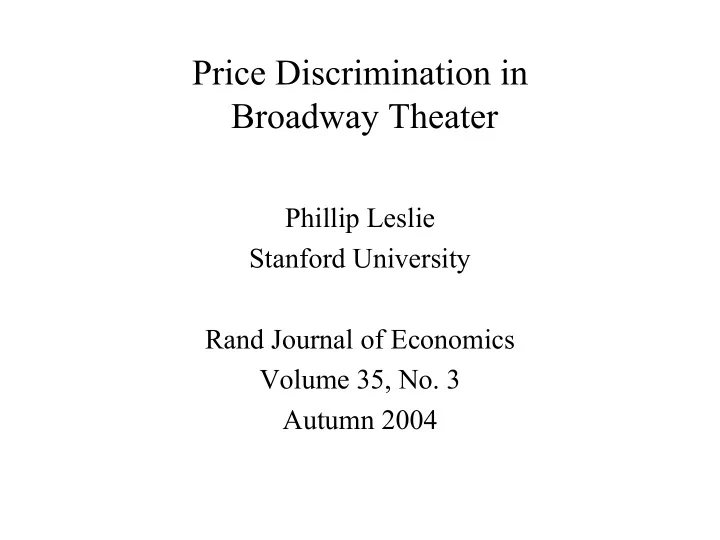

Price Discrimination in Broadway Theater Phillip Leslie Stanford University Rand Journal of Economics Volume 35, No. 3 Autumn 2004
Content • Price discrimination and Variation • Behavioral Model and Econometric Model • Welfare analysis under price discrimination • Alternative experiments and the empirical implications
Price Discrimination • 2 nd PD Different prices for different seat qualities( H, M, L) • 3 rd PD Different prices for different individuals. (Discount mail coupons or being members of specific organizations or groups) • Full Price Ticket : sold via telephone • Discount Price Ticket : 1. Coupon: sold under various conditions such as mail-in- coupon and happen-to-come-across-in- restaurant coupon 2. TKTS: will incur non-pecuniary time cost of waiting
Abstract • Behavior model: random-utility discrete choice with endogenously random choice sets • Data: 199 performances of Seven Guitar (1996), 17 different ticket categories daily prices and quantities • Experiment: price discrimination uniform pricing non-sticky prices over time abolishing the discount booth . • Results: Firms<> increase profits of 7% under PD ; consumers <> insignificant in change of aggregate CS
Identification of demand system ----price variation • Sources of Price Variation : 1. across different ticket categories (e.g. balcony <>orchestra) 2. across time (performances) in each ticket category • pre-determined peak-load pricing( Sat. evening orchestra price is higher) ; � + time-of-week dummies* • availability of medium-quality tickets from 133 rd performance � included into utility function**; • time-of-week peak load pricing � +*; • 50% off the top full price at booth varied from day to day � **;
Identification of demand system ---other variables • Advertising * positive effect on utility * Moving Average of daily ad expenditure — due to time lag from ad to attend the performance • Income ( e.g. TKTS) • Number of other shows in Broadway theater (shocks from tourism, whether. etc)
Behavioral Model – Utility Function • Individual is characterized as pair • Where is the quality view of person i toward seat quality j • is the budget for entertainment expenditures • And disutility come from • With Probability , consumer i receives a coupon
Behavioral Model – Demand Function • Expected demand for ticket in category j: Where and M is the number of people attending Broadway theater in the same week/8
Econometric Model • Where and
Econometric Model • Demand • Maximum likelihood estimator is the actual number of individuals choosing j at period t
Empirical Results • Highest/lowest quality = 3.3 <>Price ratio= 3.66 • There exists disutility of buying at booth • Budget on entertainment is only 3% of income • High quality ticket sales more sensitive to income • Negative cross-elasticity with capacity constraint …
Counterfactual Experiments • optimizing prices Max • 2 benchmark cases : 1. Base-A : uses empirical prices and provides a prediction of consumer behavior 2. Base-B : uses predicted optimal prices � Very close of predicted prices and actual prices( Table 5) � Well-specified Demand and well-specified firm behavior
Counterfactual Experiments • Uniform: Optimal P=$50.04, Revenue Attendance • No-Booth-A: Revenue Attendance • No-Booth-B: Revenue Attendance • Booth-lower- than-50%: Revenue Attendance • Non-sticky: Only small increase in revenue
Recommend
More recommend